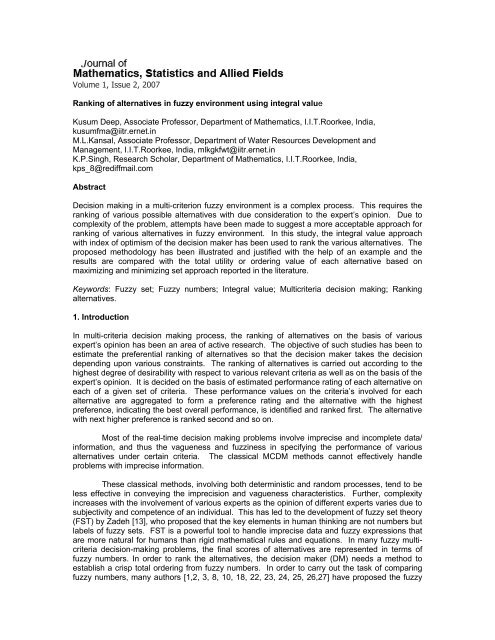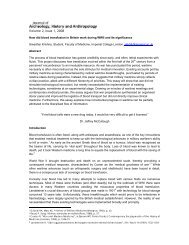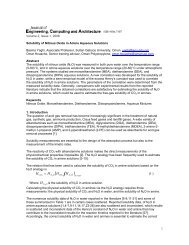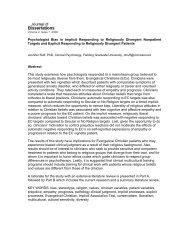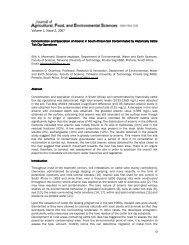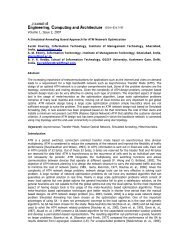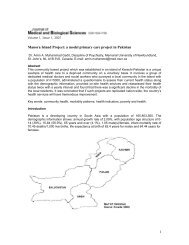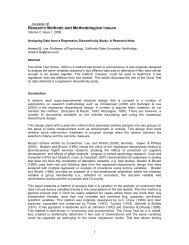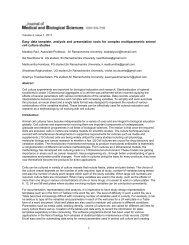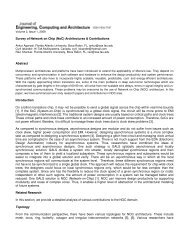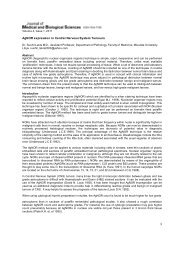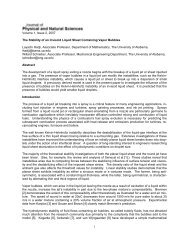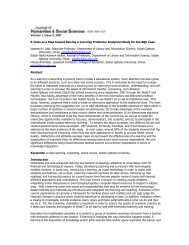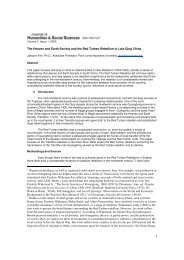Ranking of alternatives in fuzzy environment using integral value
Ranking of alternatives in fuzzy environment using integral value
Ranking of alternatives in fuzzy environment using integral value
Create successful ePaper yourself
Turn your PDF publications into a flip-book with our unique Google optimized e-Paper software.
Volume 1, Issue 2, 2007<br />
<strong>Rank<strong>in</strong>g</strong> <strong>of</strong> <strong>alternatives</strong> <strong>in</strong> <strong>fuzzy</strong> <strong>environment</strong> us<strong>in</strong>g <strong>in</strong>tegral <strong>value</strong><br />
Kusum Deep, Associate Pr<strong>of</strong>essor, Department <strong>of</strong> Mathematics, I.I.T.Roorkee, India,<br />
kusumfma@iitr.ernet.<strong>in</strong><br />
M.L.Kansal, Associate Pr<strong>of</strong>essor, Department <strong>of</strong> Water Resources Development and<br />
Management, I.I.T.Roorkee, India, mlkgkfwt@iitr.ernet.<strong>in</strong><br />
K.P.S<strong>in</strong>gh, Research Scholar, Department <strong>of</strong> Mathematics, I.I.T.Roorkee, India,<br />
kps_8@rediffmail.com<br />
Abstract<br />
Decision mak<strong>in</strong>g <strong>in</strong> a multi-criterion <strong>fuzzy</strong> <strong>environment</strong> is a complex process. This requires the<br />
rank<strong>in</strong>g <strong>of</strong> various possible <strong>alternatives</strong> with due consideration to the expert’s op<strong>in</strong>ion. Due to<br />
complexity <strong>of</strong> the problem, attempts have been made to suggest a more acceptable approach for<br />
rank<strong>in</strong>g <strong>of</strong> various <strong>alternatives</strong> <strong>in</strong> <strong>fuzzy</strong> <strong>environment</strong>. In this study, the <strong>in</strong>tegral <strong>value</strong> approach<br />
with <strong>in</strong>dex <strong>of</strong> optimism <strong>of</strong> the decision maker has been used to rank the various <strong>alternatives</strong>. The<br />
proposed methodology has been illustrated and justified with the help <strong>of</strong> an example and the<br />
results are compared with the total utility or order<strong>in</strong>g <strong>value</strong> <strong>of</strong> each alternative based on<br />
maximiz<strong>in</strong>g and m<strong>in</strong>imiz<strong>in</strong>g set approach reported <strong>in</strong> the literature.<br />
Keywords: Fuzzy set; Fuzzy numbers; Integral <strong>value</strong>; Multicriteria decision mak<strong>in</strong>g; <strong>Rank<strong>in</strong>g</strong><br />
<strong>alternatives</strong>.<br />
1. Introduction<br />
In multi-criteria decision mak<strong>in</strong>g process, the rank<strong>in</strong>g <strong>of</strong> <strong>alternatives</strong> on the basis <strong>of</strong> various<br />
expert’s op<strong>in</strong>ion has been an area <strong>of</strong> active research. The objective <strong>of</strong> such studies has been to<br />
estimate the preferential rank<strong>in</strong>g <strong>of</strong> <strong>alternatives</strong> so that the decision maker takes the decision<br />
depend<strong>in</strong>g upon various constra<strong>in</strong>ts. The rank<strong>in</strong>g <strong>of</strong> <strong>alternatives</strong> is carried out accord<strong>in</strong>g to the<br />
highest degree <strong>of</strong> desirability with respect to various relevant criteria as well as on the basis <strong>of</strong> the<br />
expert’s op<strong>in</strong>ion. It is decided on the basis <strong>of</strong> estimated performance rat<strong>in</strong>g <strong>of</strong> each alternative on<br />
each <strong>of</strong> a given set <strong>of</strong> criteria. These performance <strong>value</strong>s on the criteria’s <strong>in</strong>volved for each<br />
alternative are aggregated to form a preference rat<strong>in</strong>g and the alternative with the highest<br />
preference, <strong>in</strong>dicat<strong>in</strong>g the best overall performance, is identified and ranked first. The alternative<br />
with next higher preference is ranked second and so on.<br />
Most <strong>of</strong> the real-time decision mak<strong>in</strong>g problems <strong>in</strong>volve imprecise and <strong>in</strong>complete data/<br />
<strong>in</strong>formation, and thus the vagueness and fuzz<strong>in</strong>ess <strong>in</strong> specify<strong>in</strong>g the performance <strong>of</strong> various<br />
<strong>alternatives</strong> under certa<strong>in</strong> criteria. The classical MCDM methods cannot effectively handle<br />
problems with imprecise <strong>in</strong>formation.<br />
These classical methods, <strong>in</strong>volv<strong>in</strong>g both determ<strong>in</strong>istic and random processes, tend to be<br />
less effective <strong>in</strong> convey<strong>in</strong>g the imprecision and vagueness characteristics. Further, complexity<br />
<strong>in</strong>creases with the <strong>in</strong>volvement <strong>of</strong> various experts as the op<strong>in</strong>ion <strong>of</strong> different experts varies due to<br />
subjectivity and competence <strong>of</strong> an <strong>in</strong>dividual. This has led to the development <strong>of</strong> <strong>fuzzy</strong> set theory<br />
(FST) by Zadeh [13], who proposed that the key elements <strong>in</strong> human th<strong>in</strong>k<strong>in</strong>g are not numbers but<br />
labels <strong>of</strong> <strong>fuzzy</strong> sets. FST is a powerful tool to handle imprecise data and <strong>fuzzy</strong> expressions that<br />
are more natural for humans than rigid mathematical rules and equations. In many <strong>fuzzy</strong> multicriteria<br />
decision-mak<strong>in</strong>g problems, the f<strong>in</strong>al scores <strong>of</strong> <strong>alternatives</strong> are represented <strong>in</strong> terms <strong>of</strong><br />
<strong>fuzzy</strong> numbers. In order to rank the <strong>alternatives</strong>, the decision maker (DM) needs a method to<br />
establish a crisp total order<strong>in</strong>g from <strong>fuzzy</strong> numbers. In order to carry out the task <strong>of</strong> compar<strong>in</strong>g<br />
<strong>fuzzy</strong> numbers, many authors [1,2, 3, 8, 10, 18, 22, 23, 24, 25, 26,27] have proposed the <strong>fuzzy</strong>
ank<strong>in</strong>g methods that yield a total ordered set <strong>of</strong> rank<strong>in</strong>g. These methods can be used for a wide<br />
range <strong>of</strong> problems <strong>in</strong>volv<strong>in</strong>g one <strong>fuzzy</strong> number attribute to many <strong>fuzzy</strong> number attributes, which<br />
may be trivial to complex <strong>in</strong> nature.<br />
Generally, there are two approaches which are used for compar<strong>in</strong>g the <strong>fuzzy</strong> numbers,<br />
which are :<br />
(1) Def<strong>in</strong>e a rank<strong>in</strong>g function, f : P(R) → R where P (R)<br />
is the set <strong>of</strong> <strong>fuzzy</strong> numbers.<br />
Adamo [11], Yager [23], and Chang [28] have followed this approach.<br />
~<br />
(2) Obta<strong>in</strong> a <strong>fuzzy</strong> set <strong>of</strong> ‘optimal <strong>alternatives</strong>’, D = { i \ µ D ( i)}<br />
where µ D (i ) is the<br />
degree to which i th alternative will perform on desired optimal scale. It provides the possibility<br />
distribution <strong>of</strong> <strong>alternatives</strong> to be the best <strong>alternatives</strong>. Baas and Kwakernaak [24], Baldw<strong>in</strong> and<br />
Guild [8], Kerre [2], Watson et al. [25], Ja<strong>in</strong> [18] and Chen [23] have followed this approach.<br />
Dubois and Prade [1] suggested the four grades <strong>of</strong> dom<strong>in</strong>ance and Campos and Gonzalez [14]<br />
suggested the average-<strong>value</strong> rank<strong>in</strong>g method. Requena et al. [4, 5] and Cano et al. [7] suggested<br />
methods <strong>of</strong> automatic rank<strong>in</strong>g <strong>of</strong> <strong>fuzzy</strong> numbers us<strong>in</strong>g artificial neural networks (ANN).<br />
Chen[23] has used the maximiz<strong>in</strong>g and m<strong>in</strong>imiz<strong>in</strong>g set approach for rank<strong>in</strong>g the <strong>fuzzy</strong><br />
numbers. It depends on X max ( the <strong>in</strong>fimum <strong>of</strong> support set <strong>of</strong> the union <strong>of</strong> <strong>fuzzy</strong> weights which<br />
are be<strong>in</strong>g ranked), X m<strong>in</strong> ( the suprimum <strong>of</strong> support set <strong>of</strong> the union <strong>of</strong> <strong>fuzzy</strong> weights which are<br />
be<strong>in</strong>g ranked) and K. Raj and Kumar [16] applied this approach for rank<strong>in</strong>g the <strong>alternatives</strong>.<br />
However, Liou and Wang [26] have shown the drawback <strong>of</strong> maximiz<strong>in</strong>g and m<strong>in</strong>imiz<strong>in</strong>g set<br />
approach. It was noticed that when X max , X m<strong>in</strong> and K are changed (due to addition or deletion<br />
<strong>of</strong> any alternative), the rank<strong>in</strong>g <strong>of</strong> rema<strong>in</strong><strong>in</strong>g <strong>alternatives</strong> may also change. Thus, the rank<strong>in</strong>g<br />
order <strong>of</strong> <strong>alternatives</strong> is not consistent. They advocated the <strong>in</strong>tegral <strong>value</strong> approach for rank<strong>in</strong>g<br />
the <strong>fuzzy</strong> numbers.<br />
In this paper, we propose a method which overcomes this difficulty. The <strong>fuzzy</strong> weights <strong>of</strong><br />
the <strong>alternatives</strong> are arrived at with the help <strong>of</strong> the <strong>fuzzy</strong> <strong>in</strong>formation supplied by several experts<br />
on <strong>alternatives</strong> under various criteria. The approach suggested by Buckley [6] has been used for<br />
the purpose which is based on pool first and pool last approach. Thereafter, the rank<strong>in</strong>g <strong>of</strong> the<br />
<strong>alternatives</strong> is obta<strong>in</strong>ed us<strong>in</strong>g the concept <strong>of</strong> <strong>in</strong>tegral <strong>value</strong> approach. Further, an <strong>in</strong>dex <strong>of</strong><br />
optimism is used to reflect the DM’s optimistic attitude as suggested by Kim and Perk [11].<br />
2. Description <strong>of</strong> the problem<br />
Consider the problem <strong>of</strong> rank<strong>in</strong>g m <strong>alternatives</strong> ( A i ;i 1,<br />
2,.......,m)<br />
= by a decision maker (DM).<br />
DM wishes to select from amongst m <strong>alternatives</strong>, with the help <strong>of</strong> <strong>in</strong>formation supplied by n<br />
E j ; j = 1,<br />
2.........n<br />
about the <strong>alternatives</strong> for each <strong>of</strong> criteria<br />
experts ( )<br />
C k ; k = 1,<br />
2..........K<br />
and also the relative importance <strong>of</strong> each criteria with respect to some<br />
overall objective, which one best satisfy the criteria. The hierarchical structure which is used <strong>in</strong><br />
this paper is shown <strong>in</strong> Fig.1.<br />
Fuzzy Multi Criteria Decision Mak<strong>in</strong>g (FMCDM) methods basically consist <strong>of</strong> two phases:<br />
Phase (I) is the aggregation <strong>of</strong> the performance rat<strong>in</strong>gs (or the degree <strong>of</strong> satisfactions) with<br />
respect to all criteria for each alternative, and Phase (II) is the rank<strong>in</strong>g <strong>of</strong> the <strong>alternatives</strong><br />
accord<strong>in</strong>g to the overall aggregated performance rat<strong>in</strong>gs.<br />
2.1. Phase (I)<br />
2.1.1. Scale <strong>of</strong> preference<br />
2
Let £= l 1 , l 2 ,...... L be the preference <strong>in</strong>formation used by the experts. This scale is assumed to<br />
be f<strong>in</strong>ite, l<strong>in</strong>early ordered andl 1 < l2......<br />
< L . This £ can be an ord<strong>in</strong>al, an exact, a ratio, an<br />
<strong>in</strong>terval scale or a comb<strong>in</strong>ation <strong>of</strong> these scales. It may be easier for the experts to express their<br />
preferences <strong>in</strong> ord<strong>in</strong>al <strong>value</strong>s (l<strong>in</strong>guistic variables), especially, when there are more number <strong>of</strong><br />
alternative and qualitative criteria, and when some <strong>of</strong> the criteria is vaguely understood or<br />
imprecisely def<strong>in</strong>ed. In this case the evaluation process may be very much subjective; however, it<br />
seems more appropriate to use ord<strong>in</strong>al scale than any other scales. For comparison amongst<br />
<strong>alternatives</strong> with respect to some <strong>of</strong> the criteria, experts may prefer ord<strong>in</strong>al <strong>value</strong>s rather than<br />
numbers. The trapezoidal and triangular <strong>fuzzy</strong> numbers are the two ma<strong>in</strong> concepts used <strong>in</strong> this<br />
DM<br />
E E<br />
1<br />
2<br />
E j<br />
Objective<br />
C C<br />
1<br />
2<br />
Ck<br />
A1<br />
A 2 A i<br />
A1<br />
A 2<br />
A i<br />
Fig.1: Hierarchical structure<br />
study to assess the preference rat<strong>in</strong>g <strong>of</strong> l<strong>in</strong>guistic variables, 'importance' and 'appropriateness'.<br />
The experts may employ an assumed weight<strong>in</strong>g set W = {Very Low, Low, Medium, High, and<br />
Very High} to assess the relative importance <strong>of</strong> various criteria and use the l<strong>in</strong>guistic rat<strong>in</strong>g set S<br />
= {Very Poor, Poor, Fair, Good, and Very Good} to evaluate the appropriateness <strong>of</strong> the<br />
<strong>alternatives</strong> versus various criteria. The membership functions <strong>of</strong> the l<strong>in</strong>guistic <strong>value</strong>s <strong>in</strong> the<br />
weight<strong>in</strong>g set W and l<strong>in</strong>guistic rat<strong>in</strong>g set S can be represented by the approximate reason<strong>in</strong>g <strong>of</strong><br />
trapezoidal <strong>fuzzy</strong> numbers.<br />
2.1.2. Fuzzy numbers<br />
Let a ~ i be a <strong>fuzzy</strong> number which is a <strong>fuzzy</strong> subset <strong>of</strong> R (real numbers) and is considered <strong>in</strong> the<br />
form <strong>of</strong> a ~<br />
i = { αi<br />
/ βi<br />
, γi<br />
/ δi} , i = 1,<br />
2......<br />
m<br />
(1)<br />
where α < β < γ < δ ∈ £, £ is the scale <strong>of</strong> preference <strong>in</strong>formation to be used by the experts.<br />
2.1.3. Membership functions<br />
Membership function <strong>of</strong> a <strong>fuzzy</strong> number<br />
a ~ i is def<strong>in</strong>ed as:<br />
3
f<br />
a ~<br />
i<br />
⎧0,<br />
⎪<br />
⎪ f<br />
⎪<br />
( x ) = ⎨1,<br />
⎪<br />
⎪ f<br />
⎪<br />
⎩0,<br />
L a ~<br />
i<br />
R a ~<br />
i<br />
( x)<br />
,<br />
( x)<br />
,<br />
β<br />
x ≤ α<br />
α<br />
i<br />
γ<br />
i<br />
i<br />
≤ x ≤ β ,<br />
≤ x ≤ δ ,<br />
x ≥ δ<br />
i<br />
≤ x ≤ γ ,<br />
i ,<br />
,<br />
i<br />
i<br />
i<br />
(2)<br />
f<br />
a~<br />
i<br />
1<br />
0<br />
α<br />
β<br />
γ<br />
δ<br />
Fig.2: Graphical representation <strong>of</strong> trapezoidal <strong>fuzzy</strong> number<br />
L<br />
a i i<br />
where f % :α [ , β] →[ 01 , ] and f % :[ γ , δ ] →[ 01 , ] . S<strong>in</strong>ce f :α [ , β] →[ 01 , ]<br />
i<br />
R<br />
a i i<br />
i<br />
L<br />
a % i i<br />
is<br />
cont<strong>in</strong>uous and strictly <strong>in</strong>creas<strong>in</strong>g, the <strong>in</strong>verse function <strong>of</strong> f ~<br />
i exists. Similarly,<br />
R R<br />
f a % :[ γ i , δ i ] →[ 01 , ] is cont<strong>in</strong>uous and strictly decreas<strong>in</strong>g, the <strong>in</strong>verse function <strong>of</strong> f a~ i also<br />
i<br />
exists.<br />
The <strong>in</strong>verse functions <strong>of</strong><br />
i<br />
L<br />
a<br />
L<br />
f a~ R<br />
i and f a~ L<br />
i is denoted by g a ~ R<br />
i and g a ~ i respectively.<br />
L<br />
S<strong>in</strong>ce f a :α [ ] [ 01]<br />
i i , β i → ,<br />
g L :[ 01 , ] →[ α , β ]<br />
a i<br />
i i<br />
f % :[ γ , δ ] →[ 01 , ] is cont<strong>in</strong>uous and strictly decreas<strong>in</strong>g, then g :[ 01 , ] →[ γ , δ ]<br />
% is cont<strong>in</strong>uous and strictly <strong>in</strong>creas<strong>in</strong>g, therefore,<br />
% is also cont<strong>in</strong>uous and strictly <strong>in</strong>creas<strong>in</strong>g. Similarly, if<br />
R<br />
a i i i<br />
L<br />
cont<strong>in</strong>uous and strictly decreas<strong>in</strong>g; g a ~ i and<br />
L<br />
they are <strong>in</strong>tegrable on [0,1]. That is,<br />
∫ g ai<br />
(<br />
R a % i<br />
i i is also<br />
R<br />
g a ~ i are cont<strong>in</strong>uous on a closed <strong>in</strong>terval [0,1] and<br />
R<br />
dy g a ~ i ( y)<br />
exists.<br />
~ y)<br />
and ∫ dy<br />
4
⎧0<br />
, x ≤ α i , ⎫<br />
⎪<br />
⎪<br />
( x −α i) / ( β i −α i)<br />
, α i ≤ x ≤β i ,<br />
⎪<br />
⎪<br />
f a% = 1 ,<br />
i<br />
⎨<br />
β i ≤ x ≤ γ i , ⎬<br />
(3)<br />
⎪<br />
( i x ) / ( i i)<br />
, i x i ,<br />
⎪<br />
⎪<br />
δ − δ − γ γ ≤ ≤ δ<br />
⎪<br />
⎪<br />
⎩0<br />
, x ≥ δ i , ⎪<br />
⎭<br />
The trapezoidal membership function <strong>of</strong> an alternative a ~ i<br />
is considered <strong>in</strong> the form <strong>of</strong> Eq.<br />
(3), which is shown <strong>in</strong> Fig.2. If β<br />
i<br />
= γi<br />
then it represents triangular <strong>fuzzy</strong> number and<br />
α = β = γ = δ represents a crisp number.<br />
i<br />
i<br />
i<br />
i<br />
2.1.4. Rat<strong>in</strong>g assignment by the experts<br />
Let the experts ( E j<br />
; j = 1,2.......... . n ) assign rat<strong>in</strong>g <strong>in</strong> terms <strong>of</strong> <strong>fuzzy</strong> numbers or l<strong>in</strong>guistic<br />
variable to the <strong>alternatives</strong> ( A i<br />
; i = 1,2..........<br />
m ) for each <strong>of</strong> K criteria ( C k ;k = 1,<br />
2.......<br />
K ) and<br />
also to each criteria. Let<br />
k k k k k<br />
a %<br />
ij = α ij / β ij , γ ij / δ ij<br />
(4)<br />
( )<br />
be the <strong>fuzzy</strong> number assigned to alternative<br />
A<br />
i<br />
by expert<br />
E<br />
j<br />
for criteria<br />
C k . This means that<br />
k<br />
a ~ ij measures how well A<br />
i<br />
satisfies C k for expert E j . For each criterion k, the correspond<strong>in</strong>g<br />
j<br />
membership function can be represented as f a ~ i ( x ) (similar to Eq. (3)) and this data can be<br />
expressed <strong>in</strong> the matrix form as shown <strong>in</strong> Eq.(5).<br />
E E E<br />
1 2<br />
⎡<br />
⎤<br />
⎢ j k ⎥<br />
Rk = Ai ⎢f a% ( x)<br />
= a %<br />
i ij ⎥.<br />
⎢<br />
⎥<br />
⎣<br />
⎦<br />
n<br />
Similarly, let<br />
C %<br />
kj = εkj / ζkj , ηkj / θkj<br />
(6)<br />
( )<br />
be a <strong>fuzzy</strong> number given to criteria<br />
C k by expert<br />
E<br />
j<br />
. Thus,<br />
C ~<br />
kj<br />
(5)<br />
<strong>in</strong>dicates the importance <strong>of</strong><br />
C k for expert E j with respect to an overall objective. The membership function <strong>of</strong> these <strong>fuzzy</strong><br />
j<br />
numbers can be represented as f Ck ( x)<br />
and <strong>in</strong> matrix form as <strong>in</strong> Eq. (7)<br />
E E E<br />
1 2<br />
⎡<br />
⎤<br />
⎢<br />
⎥<br />
R = C<br />
⎢<br />
⎥<br />
k ⎢ j<br />
.<br />
f C ( x)<br />
= c%<br />
⎥<br />
⎢ k kj<br />
⎥<br />
⎢⎣<br />
⎥⎦<br />
n<br />
(7)<br />
5
2.1.5. Aggregation <strong>of</strong> performance rat<strong>in</strong>g<br />
Given the data R k and R , the DM computes the <strong>fuzzy</strong> weights ( w ~ i ; i = 1,2.........<br />
m ) <strong>of</strong> the<br />
<strong>alternatives</strong>. The <strong>fuzzy</strong> weights for each <strong>of</strong> the <strong>alternatives</strong> can be derived at by pool<strong>in</strong>g,<br />
averag<strong>in</strong>g or aggregat<strong>in</strong>g across experts. This task can be performed <strong>in</strong> two ways; i.e., “pool-first"<br />
and "pool-last".<br />
2.1.5.1. Pool-first approach<br />
The pool first approach is as follows:<br />
Step1.F<strong>in</strong>d the averages <strong>of</strong> <strong>fuzzy</strong> numbers across all the experts first as<br />
k k k<br />
P ik = 1/ n ⊗ ai1⊕a i2⊕...... ⊕a<strong>in</strong><br />
Q k = 1/ n ⊗ Ck1⊕C k2⊕....Ckn<br />
( ) ( )<br />
% % % % And ( ) ( )<br />
% % % % , (8)<br />
P ~ , Q ~ ∈£ where ⊕ and ⊗are <strong>fuzzy</strong> addition and multiplication, respectively.<br />
ik k<br />
The <strong>fuzzy</strong> numbers shown <strong>in</strong> Eq. (8) are simply the row averages <strong>of</strong> matrices given <strong>in</strong> Eqs. (5)<br />
and (7) respectively, P ~ ik is the <strong>fuzzy</strong> rank<strong>in</strong>g <strong>of</strong> A i for criteria C k and Q ~ k is the <strong>fuzzy</strong> rank<strong>in</strong>g<br />
<strong>of</strong>C k .<br />
Step2.To determ<strong>in</strong>es the <strong>fuzzy</strong> weights ( w ~ i ) <strong>of</strong> the <strong>alternatives</strong>, multiply P ~ iK andQ ~<br />
K , f<strong>in</strong>d the<br />
average over all criteria as<br />
w %<br />
i = / KL ⊗ Pi ⊗Q ⊕ Pi ⊗Q ⊕....... ⊕ PiK ⊗Q K .<br />
(9)<br />
{ }<br />
( 1 ) (<br />
% %<br />
1 1) (<br />
% %<br />
2 2) (<br />
% %<br />
)<br />
2.1.5.2 Pool-last approach<br />
The pool first approach is as follows:<br />
Step1 . Compute <strong>fuzzy</strong> weightw ~ ij<br />
for alternative A i<br />
to each <strong>of</strong> the expertE j<br />
.<br />
average over all the criteria and can be estimated as<br />
1 2<br />
( 1 ) {( ) ( ) ( )}<br />
1 2<br />
K<br />
w %<br />
ij = / KL ⊗ a% ij ⊗c% j ⊕ a% ij ⊗c %<br />
j ⊕......... ⊕ a% ij ⊗c% Kj . (10)<br />
Step2.To determ<strong>in</strong>e f<strong>in</strong>al weight ( w ~ ′<br />
i<br />
) <strong>of</strong> the <strong>alternatives</strong>, pooled <strong>fuzzy</strong> weight (<br />
ij<br />
experts as<br />
( 1 ) ( )<br />
i i1 i2<br />
<strong>in</strong><br />
w ~ ij<br />
is the <strong>fuzzy</strong><br />
w ~ ) across all the<br />
w %′ = / n ⊗ w% ⊕w % ⊕........ ⊕w % .<br />
(11)<br />
w ~ may be easily computed us<strong>in</strong>g standard <strong>fuzzy</strong><br />
In Pool-First approach <strong>fuzzy</strong> weight<br />
i<br />
arithmetic as shown below. Let α ik , βik<br />
, γik<br />
and δ ik be averages across experts <strong>of</strong><br />
k k k k<br />
α ij , β ij , γ ij and δ ij , respectively. Similarly let εk , ζ k , ηk<br />
and δk<br />
be def<strong>in</strong>ed as the averages<br />
across experts <strong>of</strong> ε kj , ζ kj , ηkj<br />
and δ kj , respectively. i.e.,<br />
( k<br />
k<br />
αik = ∑ α ij )/<br />
n , j = 1,<br />
2..........n,<br />
βik = ( ∑ β ij )/<br />
n , j = 1,<br />
2......<br />
n<br />
( k<br />
k<br />
γik = ∑ γ ij )/<br />
n, j = 1,<br />
2.......n,<br />
δik = ( ∑ δ ij )/<br />
n, j = 1,<br />
2........n.<br />
εk = ( ∑ εkj<br />
)/<br />
n, j = 1,<br />
2.........<br />
n k = ( ζ kj )/<br />
n, j −1,<br />
2.........n,<br />
γ = ( ∑ γ )/<br />
n, j = 1,<br />
.........n,<br />
= ( θ )/<br />
n, j = 1,<br />
........n.<br />
k kj<br />
2<br />
ζ ∑<br />
(12)<br />
θk ∑ kj 2<br />
6
Let the <strong>fuzzy</strong> weight be described as :<br />
w% i = ( αi[ L i1,L i2] / βi, γi / δi[ U i1,U i2]<br />
).<br />
(13)<br />
Where,<br />
( α ik k )/<br />
KL<br />
( ∑ β ik ζ k )/<br />
KL<br />
( ∑ γ ik η k )/<br />
KL<br />
( ∑ δ ik θ k )/<br />
KL<br />
{ ( βik<br />
− αik<br />
)( ζ k − k )}/<br />
KL<br />
[ { αik<br />
( ζ k − εk<br />
) + εk<br />
( βik<br />
− ik )}] / KL<br />
{ ( δik<br />
− γik<br />
)( θk<br />
− k )}/<br />
KL<br />
=−⎡<br />
{ δ θ −η +θ δ −γ } ⎤<br />
∑<br />
α ,<br />
i = ∑ ε<br />
β i =<br />
,<br />
γ i =<br />
,<br />
δ i =<br />
,<br />
Li = ∑ ε<br />
1 ,<br />
Li = ∑ α<br />
2 ,<br />
U i = ∑ η<br />
1 ,<br />
U i2<br />
ik( k k ) k( ik ik ) / KL.<br />
⎣<br />
⎦<br />
The Graph <strong>of</strong> the membership function <strong>of</strong> w ~ i<br />
is: zero to the left <strong>of</strong><br />
2<br />
2<br />
Li 1 y + Li2<br />
y + αi<br />
= x on [ α , β ];<br />
horizontal l<strong>in</strong>e (y=1) between[ β , γ ] ; Ui y + U i 2 + δi<br />
i i<br />
i i 1 on<br />
[ γi,<br />
δi]<br />
and zero to the right <strong>of</strong> δ<br />
i<br />
(x-axis is horizontal l<strong>in</strong>e and y-axis vertical). Theorems related<br />
to these equations, the pro<strong>of</strong>s and properties are well described <strong>in</strong> Dubois and Prade[1] and<br />
Buckley[6]. Membership function <strong>of</strong> <strong>fuzzy</strong> weight w ~ i<br />
is described as <strong>in</strong> Eq.(14), which is drum<br />
like shape.<br />
⎧0, x≤αi'<br />
⎪<br />
2<br />
1/<br />
2<br />
⎪ −<br />
2<br />
L i2 / 2Li1 + {( L i2 / 2Li1) + ( x −α i)<br />
/ L i1}<br />
, α i ≤ x ≤ Li1y + Li2y +α i,<br />
⎪<br />
⎪<br />
f x , L y L y x U y U y ,<br />
( )<br />
2 2<br />
w%<br />
= 1<br />
i<br />
⎨<br />
i1 + i2 +αi ≤ ≤ i1 + i2<br />
+δi<br />
⎪<br />
2<br />
1/<br />
2<br />
2<br />
⎪− U i2 / 2Ui1+ U i2 / 2Ui1 + x −δ i /U i1 ,Ui1y + Ui2y+δi ≤ x ≤δi,<br />
{( ) ( ) }<br />
⎪<br />
⎪0, x≥δ<br />
⎩<br />
2<br />
from Eq.(2 and 14) =− 2 + ( 2 ) + ( −α )<br />
i<br />
{ } 1 / 2<br />
α ;<br />
i<br />
(14)<br />
L<br />
w % i 2 i 1 i 2 i 1 i i 1 ,and<br />
f L / L L / L x / L<br />
i<br />
{( ) 2<br />
( ) } 1 / 2<br />
R<br />
w % =− i 2 2 i 1+ i 2 2 i 1 + −δ i i 1 . (15)<br />
f U / U U / U x /U<br />
i<br />
Above discussion can be easily extend for pool-last approach. Here our discussion is for only<br />
pool-first approach.<br />
2.2. Phase (II)<br />
2.2.1. Integral <strong>value</strong> approach for rank<strong>in</strong>g <strong>of</strong> <strong>alternatives</strong><br />
Integral <strong>value</strong> approach has been used, on the basis <strong>of</strong> aggregated <strong>fuzzy</strong> weights, to calculate<br />
7
the f<strong>in</strong>al rank<strong>in</strong>g order <strong>of</strong> the <strong>alternatives</strong>. This method, which is <strong>in</strong>dependent <strong>of</strong> the type <strong>of</strong><br />
membership function used and the normality <strong>of</strong> the function, can rank more than two <strong>fuzzy</strong><br />
numbers simultaneously. It is relatively simple <strong>in</strong> computation. Further, an <strong>in</strong>dex <strong>of</strong> optimism has<br />
been used to reflect the DM’s optimistic attitude.<br />
L<br />
Let g w ~ R<br />
i and g w ~ L<br />
i are <strong>in</strong>verse functions <strong>of</strong> f w~ R<br />
i and f w~ i (Eq. 15), respectively.<br />
L<br />
g wi<br />
~ 2<br />
= Li1<br />
y + Li2<br />
y + αi<br />
, and L<br />
g ~ 2<br />
wi = U i1<br />
y + U i2<br />
y + δ i . (16)<br />
Left <strong>in</strong>tegral <strong>value</strong> <strong>of</strong><br />
I<br />
L<br />
( w ~<br />
i<br />
) =<br />
∫<br />
= L<br />
w ~ i<br />
is def<strong>in</strong>ed as<br />
1<br />
L<br />
g w ~<br />
i<br />
( y )dy<br />
0 (17)<br />
i1<br />
/ 3 + Li2<br />
/ 2 + αi<br />
and Right <strong>in</strong>tegral <strong>value</strong> <strong>of</strong><br />
1<br />
R<br />
R( %<br />
i) = ∫ w%<br />
( )<br />
0 i<br />
I w g y dy<br />
w ~ is def<strong>in</strong>ed as<br />
= U /3 + U /2 + δ .<br />
i<br />
i1 i2<br />
i<br />
Total <strong>in</strong>tegral <strong>value</strong> with <strong>in</strong>dex <strong>of</strong> optimism, µ [0, 1], is def<strong>in</strong>ed as<br />
µ<br />
I T ( w% i) =µ IR( w% i) + ( 1−µ<br />
) IL( w %<br />
i)<br />
.<br />
[ 3 2 ] ( 1 )[ 3 2 ]<br />
=µ U / + U / +δ + −µ L / + L / +α .<br />
i1 i2 i i1 i2<br />
i<br />
The <strong>in</strong>dex <strong>of</strong> optimism (µ ) represents degree <strong>of</strong> optimism for a decision maker. A larger<br />
µ <strong>in</strong>dicates a higher degree <strong>of</strong> optimism. More Specifically, when µ =0, total <strong>in</strong>tegral <strong>value</strong><br />
0<br />
I ( ~ T w i<br />
) which represents a pessimistic DM’s viewpo<strong>in</strong>t is equal to the left <strong>in</strong>tegral <strong>value</strong> <strong>of</strong> w ~<br />
i<br />
i.e I ( ~<br />
L<br />
w<br />
i<br />
) . Conversely, for an optimistic decision maker, i.e. µ =1, total <strong>in</strong>tegral <strong>value</strong><br />
1<br />
I ( ~ ) is equal to I w~<br />
) . For a moderate decision maker, with µ =0.5, total <strong>in</strong>tegral <strong>value</strong><br />
R<br />
(<br />
i<br />
T w i<br />
05<br />
becomes I . = 1/ 2⎡<br />
( ) ( )<br />
T ⎣I w% + I w% ⎤<br />
R i L i ⎦<br />
.<br />
The total <strong>in</strong>tegral <strong>value</strong> function I µ<br />
( ~<br />
T w<br />
i<br />
) has the follow<strong>in</strong>g properties:<br />
(1) if I µ ( ~<br />
T wi<br />
) < I µ ( ~<br />
T w j ) then w ~ i < w~<br />
j ,<br />
(2) if I µ ( ~<br />
T wi<br />
) = I µ ( ~<br />
T w j ) then w ~ i = w~<br />
j ,<br />
(3) if I µ ( ~<br />
T wi<br />
) > I µ ( ~<br />
T w j ) then w ~ i > w~<br />
j .<br />
The proposed approach has the follow<strong>in</strong>g steps:<br />
Step1. Form a committee <strong>of</strong> experts, identify the selection attributes, (cost or benefit) and list all<br />
possible <strong>alternatives</strong>.<br />
Step2. Collect each expert’s op<strong>in</strong>ion for each alternative with respect to a subjective<br />
attribute and establish a decision matrix for each expert.<br />
Step3. Transform the <strong>fuzzy</strong> data (l<strong>in</strong>guistic expressions or <strong>fuzzy</strong> assessments) <strong>in</strong>to standardized<br />
positive trapezoidal <strong>fuzzy</strong> numbers attribute.<br />
Step4. Assign relative importance <strong>of</strong> criteria for each expert.<br />
(18)<br />
(19)<br />
8
Step5. Under each subjective criteria, aggregate all expert’s <strong>fuzzy</strong> op<strong>in</strong>ions for each alternative<br />
us<strong>in</strong>g Eqs(8)–(14). This step gives us <strong>fuzzy</strong> weight <strong>of</strong> <strong>alternatives</strong>.<br />
Step6. Order or rank the <strong>alternatives</strong> accord<strong>in</strong>g to the total <strong>in</strong>tegral <strong>value</strong>s and select<br />
the alternative with the maximum total <strong>in</strong>tegral <strong>value</strong> as the best alternative.<br />
3. Illustrative Example<br />
A decision maker wishes to rank three <strong>alternatives</strong> ( A i ; i = 1,2,3, ) across the two criteria<br />
( C K ; K = 1,2) us<strong>in</strong>g the <strong>in</strong>formation supplied by four experts ( E j ; j = 1,2,3,4 )<br />
numbers used by the experts areα β , γ , δ ∈<br />
. The <strong>fuzzy</strong><br />
, £ (0, 1, 2………, 20). For the qualitative (l<strong>in</strong>guistic)<br />
evaluation, these experts may use standard <strong>fuzzy</strong> numbers, suggested by DM, or different <strong>fuzzy</strong><br />
numbers. In this example, let us suppose that, the experts have used different <strong>fuzzy</strong> numbers. Let<br />
us also assume that the DM uses pool-first approach before arriv<strong>in</strong>g at f<strong>in</strong>al <strong>fuzzy</strong> weights.<br />
3.1. Assignment and Aggregation <strong>of</strong> preference rat<strong>in</strong>g<br />
Fuzzy weights <strong>of</strong> criterion by the experts are given <strong>in</strong> Table 1, which shows the importance <strong>of</strong><br />
criteria <strong>in</strong> overall objective. The preference <strong>of</strong> the experts for the <strong>alternatives</strong> correspond<strong>in</strong>g to<br />
criteria C1andC 2<br />
are given <strong>in</strong> Table 2 and Table 3, respectively.<br />
Table 1: <strong>Rank<strong>in</strong>g</strong> <strong>of</strong> criteria by experts<br />
E 1<br />
E 2<br />
E 3<br />
E 4<br />
C (12/14,16/18) (8/10,12/14) (10/12,14/16) (10/12,14/16)<br />
1<br />
C (6/8,10/12) (12/14,14/14) (0/1,2/2) (6/8,10/12)<br />
2<br />
Table 2: <strong>Rank<strong>in</strong>g</strong> <strong>of</strong> <strong>alternatives</strong> for criteria C<br />
1<br />
by experts<br />
C<br />
1<br />
E 1 E 2 E 3 E 4<br />
A 1<br />
(6/7,7/8) (4/4,5/5) (0/1,2/2) (3/4,5/6)<br />
A 2<br />
(5/7,7/8) (3/4,5/6) (0/1,2/3) (2/4,5/7)<br />
A 3<br />
(3/5,5/5) (6/7,7/8) (4/5,5/6) (5/6,6/7)<br />
Table 3: <strong>Rank<strong>in</strong>g</strong> <strong>of</strong> <strong>alternatives</strong> for criteria C<br />
2<br />
by experts<br />
C 2 E 1 E 2 E 3 E 4<br />
A 1<br />
(6/7,7/8) (6/7,7/8) (8/8,8/8) (6/7,8/9)<br />
A 2<br />
(5/7,7/8) (5/7,7/9) (7/8,8/9) (5/7,8/9)<br />
A 3<br />
(3/4,4/5) (5/6,6/7) (4/5,6/6) (4/6,7/7)<br />
9
Fuzzy weights <strong>of</strong> <strong>alternatives</strong>, after apply<strong>in</strong>g pool-first approach, are-<br />
2<br />
{( ) ( ) }<br />
⎧<br />
12 /<br />
⎪− . 7469 / 2( . 0703) + . 7469 / 2( . 0703)<br />
+ x −1. 7875 /. 0703 ,<br />
⎪<br />
⎪<br />
2<br />
. 7875 ≤x ≤ . 0703y + . 7469y + 1. 7875,<br />
⎪<br />
2 2<br />
fw%<br />
( x ) = 1 , . 0703y . 7469y 1. 7875 x . 0437y . 8566y 4. 1625,<br />
1<br />
⎨<br />
+ + ≤ ≤ − +<br />
⎪<br />
1/<br />
2<br />
⎪. 8562 / 2 . 0437 + − . 8562 / 2 . 0437 + x −4. 1625 /. 0437 ,<br />
⎪<br />
⎪<br />
⎪⎩<br />
2<br />
{( ) ( ) }<br />
( ) ( )<br />
2<br />
{( ) ( ) }<br />
2<br />
. 0437y − . 8566y + 4. 1625 ≤x≤4. 1625,<br />
⎧<br />
1/<br />
2<br />
⎪− 1. 0031/ 2( . 1516) + 1. 0031/ 2( . 1516)<br />
+ x −1. 45 /. 1516 ,<br />
⎪<br />
⎪<br />
2<br />
1. 45 ≤x ≤ . 1516y + 1. 0031y + 1. 45,<br />
⎪<br />
2 2<br />
fw%<br />
( x ) = 1 1516 1 0031 1 45 0938 1 3313 4 5875<br />
2<br />
⎨ , . y + . y + . ≤x ≤. y − . y + . ,<br />
⎪<br />
2<br />
1/<br />
2<br />
⎪1 . 3313/ 2( . 0938) + {( − 1. 3313/ 2( . 0938)<br />
) + ( x −4. 5875)<br />
/. 0938}<br />
,<br />
⎪<br />
⎪<br />
2<br />
. 0938y − 1. 3313y + 4. 5875 ≤x≤<br />
⎪⎩<br />
2<br />
{( ) ( ) }<br />
4. 5875,<br />
⎧ 12 /<br />
⎪ − . 9 / 2( . 1172) + . 9 / 2( . 1172)<br />
+ x − 1. 7250 /. 1172 ,<br />
⎪<br />
⎪ 2<br />
1. 7250 ≤x ≤ . 1172 y + . 9y + 1. 7250 ,<br />
⎪<br />
2 2<br />
fw%<br />
( x ) = 1 1172 9 1 7250 05 9063 4 1625<br />
3<br />
⎨ , . y + . y + . ≤x ≤. y − . y + . ,<br />
⎪<br />
2<br />
12 /<br />
⎪ . 9063/ 2( . 05) + {( − . 9063/ 2( . 05)<br />
) + ( x −4. 1625)<br />
/. 05}<br />
,<br />
⎪<br />
⎪<br />
2<br />
. 05y − . 9063 y + 4. 1625 ≤x ≤4. 1625,<br />
⎪⎩<br />
3.2. <strong>Rank<strong>in</strong>g</strong> <strong>of</strong> <strong>alternatives</strong><br />
<strong>Rank<strong>in</strong>g</strong> order <strong>of</strong> <strong>alternatives</strong> A 1 , A 2 and A 3 with different degree <strong>of</strong> optimism (µ ) <strong>of</strong> DM as<br />
suggested earlier have been calculated and results are shown <strong>in</strong> Table 4. Results, <strong>in</strong> Table 4,<br />
show that as the <strong>value</strong> <strong>of</strong> µ is changed, rank<strong>in</strong>g order <strong>of</strong> <strong>alternatives</strong> also changes. For<br />
pessimistic (µ =0) DM rank<strong>in</strong>g order is A 3 > A 1 > A 2 , while for optimistic (µ =1) DM rank<strong>in</strong>g order<br />
is A 2 > A 1 > A 3 .<br />
Table 4: Result by proposed method with different degree <strong>of</strong> optimism <strong>of</strong> decision maker<br />
µ 0.0 0.25 0.5 0.75 1.0<br />
<strong>Rank<strong>in</strong>g</strong> Alt I µ ( ~<br />
T w<br />
i<br />
) Alt I µ ( ~<br />
T w<br />
i<br />
) Alt I µ ( ~<br />
T w<br />
i<br />
) Alt I µ ( ~<br />
T w<br />
i<br />
) Alt I µ ( ~ T w<br />
i<br />
)<br />
1 A 3<br />
1.1070 A 3<br />
1.2960 A 2<br />
1.4888 A 2<br />
1.7327 A 2<br />
1.9766<br />
2 A 1<br />
1.0922 A 1<br />
1.2878 A 3<br />
1.4850 A 1<br />
1.6789 A 1<br />
1.8745<br />
3 A 2<br />
1.0010 A 2<br />
1.2449 A 1<br />
1.4833 A 3<br />
1.6740 A 3<br />
1.8630<br />
10
In order to compute the results with maximization and m<strong>in</strong>imization set approach (Raj<br />
and Kumar [16]), the rank<strong>in</strong>g <strong>of</strong> alternative was carried out by this approach and is shown <strong>in</strong><br />
Table 5. This shows rank<strong>in</strong>g order is A 3 > A 2 > A 1 .<br />
Table 5: Result by maximiz<strong>in</strong>g and m<strong>in</strong>imiz<strong>in</strong>g set approach<br />
<strong>Rank<strong>in</strong>g</strong> 1 2 3<br />
Alternative A 3<br />
A 2<br />
A 1<br />
<strong>Rank<strong>in</strong>g</strong> Value 0.4907 0.4875 0.4863<br />
After gett<strong>in</strong>g the rank<strong>in</strong>g order <strong>of</strong> three <strong>alternatives</strong>, suppose DM <strong>in</strong>troduces another<br />
alternative A<br />
4<br />
for rank<strong>in</strong>g with above <strong>alternatives</strong> whose experts op<strong>in</strong>ion for criteria C 1<br />
and<br />
C<br />
2<br />
are given <strong>in</strong> Table 6 and Table 7, respectively. Membership function <strong>of</strong> alternative A 4 , by<br />
pool-first approach, is<br />
⎧ 2<br />
1/<br />
2<br />
⎪ − 1. 74006 / 2( . 1906) + {( 1. 74006 / 2( . 1906)<br />
) + ( x − 3. 8)<br />
/. 1906}<br />
,<br />
⎪<br />
⎪ 2<br />
3. 8 ≤x ≤ . 1906y + 1. 74006y + 3. 8,<br />
⎪<br />
2 2<br />
fw%<br />
( x ) = 1 1906 1 74006 3 8 1250 2 175 9 3<br />
4<br />
⎨ , . y + . y + . ≤x ≤. y − . y + . ,<br />
⎪<br />
2<br />
1/<br />
2<br />
⎪2. 175 / 2( . 1250) + {( − 2. 175 / 2( . 1250)<br />
) + ( x −9. 3)<br />
/. 1250}<br />
,<br />
⎪<br />
⎪<br />
2<br />
. 1250y − 2175 . y + 93 . ≤x ≤93<br />
. ,<br />
⎩⎪<br />
Table 6: <strong>Rank<strong>in</strong>g</strong> <strong>of</strong> <strong>alternatives</strong> for criteria C<br />
1<br />
by experts<br />
C<br />
1<br />
E 1 E 2<br />
E 3<br />
E 4<br />
A (8/9,10/10) (14/16,16/18) (10/10,12/14) (6/12,14/16)<br />
4<br />
Table 7: <strong>Rank<strong>in</strong>g</strong> <strong>of</strong> <strong>alternatives</strong> for criteria C 2 by experts<br />
C<br />
2<br />
E 1<br />
E 2<br />
E 3<br />
E 4<br />
A (8/10,10/12) (10/12,12/14) (10/10,12/14) (10/12,14/16)<br />
4<br />
Now, rank<strong>in</strong>g order <strong>of</strong> all four <strong>alternatives</strong>, aga<strong>in</strong>, has been found with both the techniques.<br />
<strong>Rank<strong>in</strong>g</strong> order <strong>of</strong> all four <strong>alternatives</strong> with different degree <strong>of</strong> optimism for DM, by <strong>in</strong>tegral <strong>value</strong><br />
approach, is shown <strong>in</strong> Table 8. For pessimistic (µ =0) DM rank<strong>in</strong>g order <strong>of</strong> <strong>alternatives</strong> is<br />
A<br />
4<br />
> A 3 > A 1 > A 2 , while optimistic (µ =1) DM rank<strong>in</strong>g order <strong>of</strong> <strong>alternatives</strong> is A<br />
4<br />
> A 2 > A 1 > A 3 .<br />
<strong>Rank<strong>in</strong>g</strong> order <strong>of</strong> <strong>alternatives</strong> by maximiz<strong>in</strong>g and m<strong>in</strong>imiz<strong>in</strong>g set approach is shown <strong>in</strong> Table 9,<br />
which is A<br />
4<br />
> A 2<br />
> A 3<br />
> A 1<br />
.<br />
Table 8: Result by proposed method with different degree <strong>of</strong> optimism <strong>of</strong> decision maker<br />
µ 0.0 0.25 0.5 0.75 1.0<br />
<strong>Rank<strong>in</strong>g</strong> Alt I µ ~<br />
T w ) Alt I µ ~<br />
T w ) Alt I µ ~<br />
T w ) Alt I µ ~<br />
T w ) Alt I µ ~ T w )<br />
1<br />
2<br />
3<br />
4<br />
(<br />
i<br />
A 2.3669<br />
4<br />
A 1.1070<br />
3<br />
A 1.0922<br />
1<br />
A 1.0010<br />
2<br />
(<br />
i<br />
A 2.8070<br />
4<br />
A 1.2960<br />
3<br />
A 1.2878<br />
1<br />
A 1.2449<br />
2<br />
(<br />
i<br />
A 3.2470<br />
4<br />
A 1.4888<br />
2<br />
A 1.4850<br />
3<br />
A 1.4833<br />
1<br />
(<br />
i<br />
A 3.6870<br />
4<br />
A 1.7327<br />
2<br />
A 1.6789<br />
1<br />
A 1.6740<br />
3<br />
(<br />
i<br />
A 4.1271<br />
4<br />
A 1.9766<br />
2<br />
A 1.8745<br />
1<br />
A 1.8630<br />
3<br />
11
Table 9: Result by maximiz<strong>in</strong>g and m<strong>in</strong>imiz<strong>in</strong>g set approach<br />
<strong>Rank<strong>in</strong>g</strong> 1 2 3 4<br />
Alternative<br />
A<br />
4<br />
A<br />
2<br />
A<br />
3<br />
A<br />
1<br />
<strong>Rank<strong>in</strong>g</strong> Value 0.6094 0.2483 0.2409 0.2357<br />
3.3. Results and Discussion<br />
On the basis <strong>of</strong> these results, it is observed that when a new alternative A 4 is <strong>in</strong>troduced then<br />
the results are changed while us<strong>in</strong>g maximiz<strong>in</strong>g and m<strong>in</strong>imiz<strong>in</strong>g set approach. When only three<br />
<strong>alternatives</strong>, A 1, A2<br />
and A3<br />
are ranked then the rank<strong>in</strong>g order is A<br />
3<br />
> A2<br />
> A1<br />
, and when<br />
additional alternative A 4 is <strong>in</strong>troduced then the rank<strong>in</strong>g order is A<br />
4<br />
> A2<br />
> A3<br />
> A1<br />
. In first<br />
rank<strong>in</strong>g results A 3 > A 2 , and when A 4 is <strong>in</strong>troduced <strong>in</strong> rank<strong>in</strong>g process then A 2 > A 3 , i.e., <strong>in</strong><br />
rank<strong>in</strong>g process an alternative <strong>value</strong> is affected by another alternative.<br />
In this study, mislead<strong>in</strong>g results by maximiz<strong>in</strong>g and m<strong>in</strong>imiz<strong>in</strong>g set approach has been<br />
avoided us<strong>in</strong>g <strong>in</strong>tegral <strong>value</strong> approach. <strong>Rank<strong>in</strong>g</strong> order <strong>of</strong> first three <strong>alternatives</strong> is not affected, for<br />
an optimism level <strong>of</strong> DM’s, by <strong>in</strong>troduc<strong>in</strong>g another alternative A 4 . DM’s degree <strong>of</strong> optimism is also<br />
<strong>in</strong>corporated <strong>in</strong> <strong>in</strong>tegral <strong>value</strong> approach; therefore, he gets rank<strong>in</strong>g order <strong>of</strong> <strong>alternatives</strong> for<br />
different degree <strong>of</strong> optimism. Example shows that rank<strong>in</strong>g order <strong>of</strong> <strong>alternatives</strong> is also <strong>in</strong>fluenced<br />
by DM’s optimism level. For µ = 0 (pessimistic DM) rank<strong>in</strong>g order <strong>of</strong> <strong>alternatives</strong> is<br />
A 4 > A3<br />
> A1<br />
> A2<br />
and for µ = 1(optimistic DM) rank<strong>in</strong>g order is A 4 > A2<br />
> A1<br />
> A3<br />
.<br />
4. Conclusions<br />
The proposed procedure is <strong>in</strong>tuitive, computationally simple and easy to implement <strong>in</strong> rank<strong>in</strong>g <strong>of</strong><br />
alternative, which has lot <strong>of</strong> potential for mak<strong>in</strong>g policy decisions <strong>in</strong> a large-scale, real-life and<br />
complex problems. Both qualitative and quantitative aspects are analyz<strong>in</strong>g by this method,<br />
employ<strong>in</strong>g expert’s op<strong>in</strong>ion (preference structure) us<strong>in</strong>g <strong>fuzzy</strong> numbers and l<strong>in</strong>guistic variables.<br />
Numerical results show the efficiency and reliability <strong>of</strong> <strong>in</strong>tegral <strong>value</strong> approach over maximiz<strong>in</strong>g<br />
and m<strong>in</strong>imiz<strong>in</strong>g set approach <strong>in</strong> multicriteria decision mak<strong>in</strong>g problems.<br />
Acknowledgment:<br />
One <strong>of</strong> the authors (K.P.S<strong>in</strong>gh) would like to thank Council for Scientific and Industrial Research<br />
(CSIR), New Delhi, India for f<strong>in</strong>ancial support, under grant no.09/143(0504)/2004-EMR-I.<br />
References:<br />
[1]. D. Dubois, H. Prade, <strong>Rank<strong>in</strong>g</strong> <strong>of</strong> <strong>fuzzy</strong> numbers <strong>in</strong> the sett<strong>in</strong>g <strong>of</strong> possibility theory, Inform.<br />
Sci. 30 (1980) 183-224.<br />
[2]. E.E. Kerre, The use <strong>of</strong> <strong>fuzzy</strong> set theory <strong>in</strong> electro cardiological diagnostics, <strong>in</strong>: M.M. Gupta,<br />
E. Sanchez (Eds.j, Approximate Reason<strong>in</strong>g <strong>in</strong> Decision Analysis, North-Holland, Amsterdam,<br />
1982 277-282.<br />
[3]. G. Bortolan, R. Degani, A review <strong>of</strong> some methods for rank<strong>in</strong>g <strong>fuzzy</strong> subsets, Fuzzy Sets<br />
and Systems 15 (1985) 1-19.<br />
[4]. I. Requena, M. Delgado, J.L. Verdegay, Automatic rank<strong>in</strong>g <strong>of</strong> <strong>fuzzy</strong> numbers with the<br />
criterion <strong>of</strong> decision-maker learnt by an artificial neural network, Fuzzy Sets and Systems 64<br />
(1994) 1-19.<br />
[5]. I. Requena, Neural networks <strong>in</strong> decision problems with <strong>fuzzy</strong> <strong>environment</strong> (<strong>in</strong> Spanish),<br />
Ph.D. Dissertation, Grenada, Spa<strong>in</strong>, 1992.<br />
12
[6]. J. J. Buckley, The multiple judge, multiple criteria rank<strong>in</strong>g problems - a <strong>fuzzy</strong> set approach,<br />
Fuzzy Sets and Systems 13 (1984) 25-37.<br />
[7]. J.E. Cano, M. Delgado, I. Requena, Us<strong>in</strong>g artificial neural networks to aid decision mak<strong>in</strong>g<br />
process, <strong>in</strong>: Proc. IWANN'91,Grenada (Spa<strong>in</strong>), Lecture Notes <strong>in</strong> Computer Science,<br />
Spr<strong>in</strong>ger, Madrid, 1991, pp. 461-469.<br />
[8]. J.F. Baldw<strong>in</strong>, N.C.F. Guild, Comparison <strong>of</strong> <strong>fuzzy</strong> sets on the same decision space, Fuzzy<br />
Sets and Systems 2 (1979) 213-231.<br />
[9]. J.J. Buckley, <strong>Rank<strong>in</strong>g</strong> <strong>alternatives</strong> us<strong>in</strong>g <strong>fuzzy</strong> numbers, Fuzzy Sets and Systems 15 (1985)<br />
21-31.<br />
[10]. J.M. Adamo, Fuzzy decision tree, Fuzzy Sets and Systems 4 (1980) 207-219.<br />
[11]. K. Kim and K. S.Perk,<strong>Rank<strong>in</strong>g</strong> <strong>fuzzy</strong>numberswith <strong>in</strong>dex <strong>of</strong> optimism,Fuzzy Sets and Systems<br />
35 (1990) 143-150.<br />
[12]. K.-M. Lee, C.-H. Cho and H. Lee-Kwang, <strong>Rank<strong>in</strong>g</strong> <strong>fuzzy</strong> <strong>value</strong>s with satisfaction function,d<br />
Systems 64 (1994) 295 -311.<br />
[13]. L.A. Zadeh, Fuzzy sets, Inform. and Control 8 (1965),338-353.<br />
[14]. L.M. de Campos, A. Gonzalez, A subjective approach for rank<strong>in</strong>g <strong>fuzzy</strong> numbers, Fuzzy Sets<br />
and Systems 29 (1988) 145-153.<br />
[15]. O.P.Dias Jr, <strong>Rank<strong>in</strong>g</strong> <strong>alternatives</strong> us<strong>in</strong>g <strong>fuzzy</strong> numbers: A computational approach, Fuzzy<br />
Sets and Systems 56 (1993) 247-252.<br />
[16]. P.Anand Raj and D.Nagesh Kumar, <strong>Rank<strong>in</strong>g</strong> <strong>alternatives</strong> with <strong>fuzzy</strong> weights us<strong>in</strong>g<br />
maximiz<strong>in</strong>g set and m<strong>in</strong>imiz<strong>in</strong>g set, Fuzzy Sets and Systems, 105 (1999) 365-375.<br />
[17]. Q Zhu, E.S. Lee, Comparison and rank<strong>in</strong>g <strong>of</strong> <strong>fuzzy</strong> numbers, <strong>in</strong>: J. Kacpryzk, M. Fedrizzi<br />
(Eds.), Fuzzy Regression Analysis, Omnitech press, Warsaw, 1991 21-44.<br />
[18]. R. Ja<strong>in</strong>, A procedure for multiple-aspect decision mak<strong>in</strong>g us<strong>in</strong>g <strong>fuzzy</strong> sets, Int. J. Systems<br />
Sci. 8 (1977) 1-7.<br />
[19]. R. Ja<strong>in</strong>, Decision mak<strong>in</strong>g <strong>in</strong> the presence <strong>of</strong> <strong>fuzzy</strong> variables, IEEE Trans. Systems Man<br />
Cybernet. 6 (1976) 698-702.<br />
[20]. R.R. Yager, A procedure for order<strong>in</strong>g <strong>fuzzy</strong> subsets <strong>of</strong> the unit <strong>in</strong>terval, Inform. Sci. 24 (1981)<br />
143-161.<br />
[21]. R.R. Yager, On choice between <strong>fuzzy</strong> subsets, Kybernet. 9 (1980) 151-154.<br />
[22]. R.R. Yager, <strong>Rank<strong>in</strong>g</strong> <strong>fuzzy</strong> subsets over the unit <strong>in</strong>terval, Proc. 1978 CDC, 1978 1435-1437.<br />
[23]. S.H. Chen, <strong>Rank<strong>in</strong>g</strong> <strong>fuzzy</strong> numbers with maximiz<strong>in</strong>g set and m<strong>in</strong>imiz<strong>in</strong>g set, Fuzzy Sets and<br />
Systems 17 (1985) 113-129.<br />
[24]. S.M. Baas, H. Kwakernaak, rat<strong>in</strong>g and rank<strong>in</strong>g <strong>of</strong> multiple-aspect <strong>alternatives</strong> us<strong>in</strong>g <strong>fuzzy</strong><br />
sets, Automatica 13 (1977) 47-57.<br />
[25]. S.R. Watson, J.J. Weiss, M.L. Donnel, Fuzzy decision analysis, IEEE Trans. Systems Man<br />
Cybernet. 9(1979)1-9.<br />
[26]. T.S.Liou and M.J.Wang, <strong>Rank<strong>in</strong>g</strong> <strong>fuzzy</strong> numbers with <strong>in</strong>tegral <strong>value</strong>, Fuzzy Sets and<br />
Systems, 50 (1992) 247-255.<br />
[27]. W. Chang, <strong>Rank<strong>in</strong>g</strong> <strong>of</strong> <strong>fuzzy</strong> utilities with triangular membership functions, Proc. Int. Conf. on<br />
Policy Analysis and Information systems, 1981, 263-272.<br />
13


